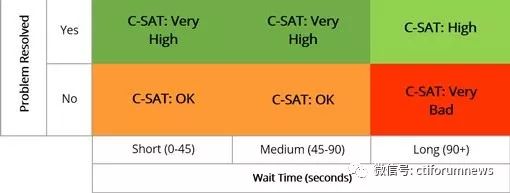In fact, the service level of the contact center is easy to calculate, but there is a lot of confusion about how to measure them.
formula
Then give you a service level expressed as a percentage.
It's really simple.
For example, if a company's goal is to answer 80% of calls within 20 seconds, the threshold for service levels is 20 seconds.
exampleThe information used in the calculations can be obtained from the contact center's Automatic Call Distribution System (ACD) or, if the acquisition fails, from the Call Detail Records (CDRs).
Number of calls answered with in these rvice level threshold = 136
Number of calls offered in the service level threshold period (Number of calls offered) = 170

Each new reporting cycle should recalculate a new level of service, and if not done in real time, most contact centers will perform calculations every half hour.
By doing so, the contact center can see if they have the correct number of agents to handle the different numbers of calls during the day.
Should the phone that was abandoned within five seconds be discounted?
In some algorithms, it is not calculated to abandon the phone for less than 5 seconds.

Dave Appleby
This is because people may have dialed the wrong number in the error and then hang up. This can be set on many ACD systems.
This is usually considered ok.
Experienced resource planner Dave Appleby said: "The duration of these calls is not even as long as a ringing cycle. Some ACDs may not even send it to the queue, even if the customer hears it. ring."
Therefore, excluding the short-term abandonment of the phone, the revised formula is:

Should all abandoned calls be excluded?
the answer is negative.
An abandoned call is a call provided by ACDs, and you have a chance to answer it.
However, it is not surprising that the so-called “abandonment rate†varies depending on the type of call. The chart below highlights this.

Since all types seem to have reached 80%, it is not surprising that this has become an industry standard.
Time usually starts after the IVR selection
In general, the service level time begins after the post-IVR selection.
The service level is based on "How many of the calls you can answer are answered in X seconds?"
"I haven't encountered this before. The service level is based on the number of calls you can answer, and how many have been answered in X seconds?" said Dave Appleby.
However, to record the number of "abandoned" calls separately, this is an effective way to measure the effectiveness of the calculated service levels.
Carefully use ACD statistics
On some ACD systems, the level of service displayed on the wall panel can be misleading.
For example, within 20 seconds, you set a goal of 80% call service level. The 100% service level data shown in your ACD statistics does not mean that 100% of calls are responded within 20 seconds.
The 100% figure actually means that 100% of calls reach the stated goal of service level (ie 100% of 80% of calls are responded within the target time). Similarly, 80% of the service level may simply mean that 64% of calls (80% 80%) get responded within the threshold time. This undoubtedly confuses many people.
In this case, it is safer to display only the percentage of call responses within 20 seconds.
Do you have to adhere to industry-standard service levels?As mentioned earlier, most contact centers adhere to the industry standard of service level, which is to receive 80% of calls within 20 seconds.
However, there are signs that the contact center has begun to relax service levels. According to our white paper, “Contact Center is doing what it is doing nowâ€, contact center professionals believe that service levels are a “very important†indicator that has fallen from 70.0% to 62.7% in just 12 months.
Those who think in this way may question the impact of service levels on customer satisfaction (CSat) and believe that spending more time on ensuring first call resolution (FCR) than focusing on meeting a particular service level More satisfied with customers.

The above table is taken from our article: “Is there a correlation between queue time and customer satisfaction?†It shows that as long as the call problem is resolved, the queue time will not have a significant impact on customer satisfaction.
However, while this is a good example, not counting time-based metrics, computing service levels remain an important part of many contact center workforce management (WFM).
How do people manipulate service levels?As with all indicators, once people see an indicator that is important, they begin to manipulate the results.
Here are three ways in which the most common service level results are manipulated:
1, does not include the phone to give up
The easiest way is to exclude the number of abandoned calls in the calculation.
For example, the Cisco Contact Center software allows for three different methods of computing service levels.
Abandoned calls have a negative impact on service levels (this is the right approach)
The number of calls responded during the threshold time divided by the number of calls in the service level event.
Abandoned calls have no effect on service levels (should not be used)
The number of calls responded during the threshold time divided by the number of calls in the call service level event minus the number of calls abandoned before the service level threshold was exceeded. Calls abandoned during the service level threshold time are deleted in this calculation.
Abandoned calls have a positive impact on service levels (used to manipulate service levels)
The number of calls responded during the threshold time plus the number of calls abandoned in the threshold, all divided by the number of calls in the service level event. This treats these abandoned calls as being answered within the threshold time.

2. Change the goal (although it is temporary)
I know that a supervisor decided on the spot that he changed the service level from 90/15 to 80/20 and then recalculated so that they would not reach the goal!
3. Join a phone screening team
Some companies have set up a telephone screening or classification team. This is similar to an enterprise switch, which is responsible for quickly answering these calls before transferring the calls in a longer queue to the appropriate department.
This is sometimes used to cover up the level of service. For example, a few years ago, a regulator measured the speed of answering calls.
Between 1996 and 2005, regulators oversaw UK companies that answered 90% of their calls within 30 seconds as part of their plan to improve customer service.
In this industry, it seems to have shown good progress. In the 30 seconds from 1996 to 1997, 26% of the calls were not answered, and between 2002 and 2003, this number dropped to 8%.
The rumor I heard was that a company tried to get around this goal by joining a small phone screening team, they took the call and then transferred it to the appropriate department (actually a switchboard). This call didn't get resolved faster, but it made the service level figures look better.
Regardless of whether this is true or not, in 2005, regulators replaced a single service level measurement with a new set of measures to provide a “more comprehensive†approach to telephone processing.
Birds House Humidifiers,Audio Full Range Speakers,Full Range Speaker,Water Dancing Speakers
NINGBO BOILINGSOUND ELECTRONICS CO.,LTD , https://www.tweeterspeaker.com